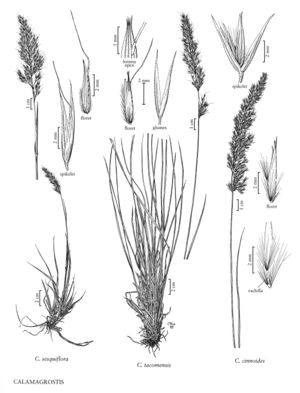Calamagrostis sesquiflora
Plants rarely with sterile culms; strongly cespitose, usually without rhizomes, sometimes with rhizomes 1-2 cm long, 1-2 mm thick. Culms (15)30-46(50) cm, unbranched, usually smooth, rarely slightly scabrous beneath the panicles; nodes 1-2(3). Sheaths and collars smooth; ligules (0.5)2-5(6) mm, usually truncate, sometimes obtuse, usually entire, sometimes lacerate; blades (3)8-25(31) cm long, (2)3-7 mm wide, flat, abaxial surfaces usually scabrous, rarely smooth, adaxial surfaces smooth or slightly scabrous, glabrous or sparsely hairy. Panicles 4-11(12) cm long, 0.8-2.5(2.8) cm wide, erect, contracted to somewhat open, usually purple-tinged, sometimes brown or green; branches 1.5-3(4) cm, scabrous, prickles sometimes almost hairlike, usually spikelet-bearing to the base, lowest branches sometimes not so. Spikelets (5)5.5-8.5(9.5) mm; rachilla prolongations (1)1.5(2.2) mm, hairs 1-2.2 mm. Glumes keeled, keels usually scabrous for their whole length, sometimes the surfaces also scabrous, lateral veins prominent, apices long-acuminate, usually twisted distally; callus hairs (0.8)1.2-1.8(3) mm, 0.1-0.4 times as long as the lemmas, abundant; lemmas (3.5)4-4.5(6) mm, (0.5)1-2.5(4.5) mm shorter than the glumes; awns (5.4)7-11(13) mm, attached to the lower 1/10 – 2/5 of the lemmas, exserted more than 2 mm, stout, easily distinguished from the callus hairs, bent; anthers (1.2)2.2-3(3.4) mm. 2n = 28.
Distribution
Alaska, Wash., Oreg., B.C.
Discussion
Calamagrostis sesquiflora grows at 0-1000 m in open heath, meadows, and forest openings, on or at the base of open rocky cliffs and knolls, as well as in moist talus. It grows in strictly maritime habitats along the west coast of North America, from the Aleutian Islands in Alaska to the Queen Charlotte Islands and south to Vancouver Island (Brooks Peninsula) in British Columbia. There is also a single collection from the coast of mainland British Columbia. In northeast Asia, it ranges into the Kamchatka Peninsula and Kuril Archipelago.
Some specimens from the northwestern United States are incorrectly identified, partly because an earlier name for Trisetum spicatum (L.) K. Richt. was Trisetum sesquiflorum Trin.
Calamagrostis sesquiflora has sometimes included C. tacomensis (see next) [as C. vaseyi Beal]. Several specimens that were previously identified as C. sesquiflora are actually C. tacomensis. Calamagrostis sesquiflora differs in preferring moister habitats, having wider leaves, callus hairs that are shorter relative to the lemmas, shorter panicle branches, and glumes that are often twisted at the apices.
Selected References
None.
